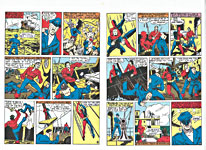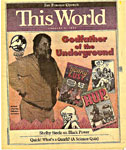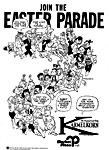 |
|||||
Opus 316 (September 29, 2013). Herein we have a hare-raising survey of September’s editorial cartoons this time, plus description of the flood devastation in Colorado. We also report on the future of Batwoman, list Harvey winners, review the Original Daredevil Archive from Dark Horse, and say farewell to Pete Hoffman—and report some news : PBS 3-hour Superhero program, manga in Japan threatened by 2020 Olympics, the comic-con record in Salt Lake City, Disney owns Marvel characters (judge pissed), Facebook suppresses naked man, editoonist gets a day in Lexington, “Luann” co-writing Luann, Bezos at the Post, and more, of course—much more. Before getting to all that, however, here’s a Timely Feetnoot: I realize with only modest regret that this posting went into production (on about September 29) before Congress could decide whether to shut down the government or not. By the time you read this, we’ll know; but at the moment, it’s all in the limbo so frequently manufactured by the Grandstanding Obstructionist Pachyderm. And so our Editoonery Department has been deprived of the dubious pleasure of harvesting a bumper crop of Congress lambasting cartoons. Over the weekend, though, we learned that if the government is shut down, the Pentagon will furlough 400,000 civilian workers and stop paying death benefits to the families of fallen soldiers. Service personnel will also be going without pay but they’ll still be required to report for duty and be shot at in the wilds of Afghanistan and elsewhere. The military generally will be prohibited from entering into any new contracts with vendors. One hopes they don’t run out of bullets. Most government agencies will be shut down except programs that do not require annual appropriations like Social Security and Medicare. And Congress. That’s right: members of Congress will continue to be paid no matter how long the rest of the government legions go penniless. This should surprise no one. Congresspersons’ paychecks haven’t been stopped through all the past five years when Congress has done nearly nothing, so this development is merely perpetuation of the colossal absurdity that is Congress—of which perhaps Ted Cruz is the colossalist: after filibustering for 21 hours against some aspect of an anti-anti-Obamacare bill, Cruz took his seat at last—and voted for it. Next time, we’ll show you how the nation’s editoonists responded to the shut down. Or the not shut down. What fun we’re having here at the Rancid Raves Intergalactic Wurlitzer. Meanwhile, to return to our regularly scheduled programming, here’s what’s here, in order, by department—:
NOUS R US Superheroes: A Never Ending Battle on PBS Future of Batwoman 2020 Olympics Threaten Manga and Anime in Japan ODDS & ADDENDA— Salt Lake City Con Rousing Success Professor Lynda Barry Disney Owns Marvel Characters (Judge Pissed) Donald Duck in Germany
Marvel’s Agents of S.H.I.E.L.D. Facebook Suppresses Naked Man Harvey Award Winners Listed Fantagraphics Looks Ahead
EDITOONIST HAS HIS OWN DAY “Luann” Co-writing Luann
EDITOONERY Some of the Best Political Cartoons of the Month The Flood in Colorado
THE FROTH ESTATE Bezos at the Washington Post Inspires Hope
Jivey Puzzle Solution
NEWSPAPER COMICS PAGE VIGIL Strange and Wonderful in Recent Funnies
BOOK MARQUEES Superman Sundays Coming Rube Goldberg Tome Jeff Smith’s New Work
BOOK REVIEW The Original Daredevil Archives
Collector’s Corniche Ron Turner Last Gasping in1991 Harv’s Karmelkorn Adv
FUNNYBOOK FAN FARE Hit Red Sonja No.3 Kings Watch
Passin’ Through Pete Hoffman, 1919-2013
Our Motto: It takes all kinds. Live and let live. Wear glasses if you need ’em. But it’s hard to live by this axiom in the Age of Tea Baggers, so we’ve added another motto:.
Seven days without comics makes one weak. (You can’t have too many mottos.)
And our customary reminder: don’t forget to activate the “Bathroom Button” by clicking on the “print friendly version” so you can print off a copy of just this installment for reading later, at your leisure while enthroned. Without further adieu, then, here we go—:
NOUS R US Some of All the News That Gives Us Fits
Never-Ending Battle Postponed for a Week The PBS program “Superheroes: A Never-Ending Battle” will appear in a single three-hour time block on October 15 instead of beginning a 3-week once-a-week series on October 8. Premiering at 8pm, it will include “insightful interviews” with such stellar comics dignitaries as Stan Lee; actors Adam West (TV’s “Batman”) and Lynda Carter (“Wonder Woman”); Geoff Johns (chief creative officer, DC Comics), Jeph Loeb (head of television for Marvel Entertainment); Pulitzer Prize-winning author Michael Chabon (The Amazing Adventures of Kavalier & Clay) and cartoonist/author Jules Feiffer (the long-running strip “Feiffer”), as well as appearances by the late comic book icons Joe Simon (co-creator of Captain America) and Jerry Robinson (who created the Joker). Narrated and hosted by Liev Schreiber (X-Men Origins: Wolverine, Showtime’s Ray Donovan), “Battle” is the first documentary to examine the dawn of the comic book genre and its powerful legacy, as well as the evolution of the characters who leapt from the pages over the last 75 years and their ongoing worldwide cultural impact, according to Jennifer Marcus at goodmanmedia.com. “It chronicles how these ‘disposable diversions’ were subject to intense government scrutiny for their influence on American children and how they were created, in large part, by the children of immigrants whose fierce loyalty to a new homeland laid the foundation for a multi-billion-dollar industry that is now an influential part of our national identity.” The three-hour program is divided into three chronological segments: 1938-1958, the “golden age” of superheroes, wartime, and the ignominious squelching of comics by the forces of Wertham; 1959-1977, superhero rebirth with bickering personalities, social issues in the comics; 1978-present, the arrival of the “dark heroes” and superhero movies. Not much in that forecast for funny animals, westerns, teenage and romance comics. But ought to be fun anyhow even with the narrow focus. A book based on “Battle” entitled Superheroes!: Capes, Cowls, and the Creation of Comic Book Culture and penned by series co-writer Laurence Maslon and filmmaker Michael Kantor will be available October 1, 2013, from Crown Archetype, a division of Random House. “This stunning companion volume tells the story of the superhero in American pop culture, with interviews, character biographies and more than 500 illustrations both essential and rare.” And the show itself will be available in DVD and Blu-ray versions on October 15, coinciding with the PBS broadcast.
The Future of Batwoman With the very public departure of J.H. Williams III and Haden Blackman from the title, DC faced not only the daunting task of finding the next set of creators for Batwoman, but they also had to deal with an added controversy. Because the outgoing writers claimed DC refused to let Batwoman get married — and since the character is in a lesbian relationship —the reversal of the marriage storyline implied to some mainstream news outlets that her sexual orientation was at the root of the anti-marriage stance. “DC needed a quick save,” said Vaneta Rogers at newsarama.com, “and they got it in the form of Marc Andreyko, who was announced as the new writer beginning with Batwoman No.25. Best known for his long run on DC's critically acclaimed Manhunter title, Andreyko has been recently writing under-the-radar stories for DC on short-lived titles like DC Universe Presents and Sword of Sorcery.” Interviewed by Rogers, Andreyko, who is gay, convincingly denied that DC was plotting against lesbians: “I think part of the brouhaha was that the Internet is always looking for the dirty story, and the lack of wanting the character to get married had nothing to do with their sexuality. It has to do with—you know, the New 52 is very young, very new, and having characters get married brings an inherent sort of age to the proceedings. It was absolutely not an anti-gay thing. It was just a creative overview that marriage right now, at this point in the DC Universe, is not something they want to explore. And that's a completely viable thing. “Any claims of homophobia against DC are completely ridiculous,” he continued. “I've been an out gay creator my entire career, and I've had nothing but support — and, if anything, pushing from DC to do more. So no, they've been one of the most consistently great places for not only LGBT characters, but for creators as well. They're ahead of the curve with the country, as far as that goes. And you know, of course, as a gay man, I would never take a job — any job — where I thought there was homophobia or anti-gay subtext at all. People who know who I am know I'm a loud-mouth. So I would be the first person to complain if that was the case, so I have nothing but praise for DC on this. “As far as Kate's sexuality and her relationship with Maggie,” he went on, “that's going to be explored in great depth. But it will be the same way that, when Peter Parker was dating Mary Jane, their sexuality was explored. It's not going to be a ‘capital G’ gay issue book, by any means. Being didactic is not something I enjoy as a writer or as a reader. There's going to be all kinds of complications in their relationship, but that's what relationships are. The moment you add two people into a room, complications arise, whether you want them to or not. “Kate’s definitely going to be much more integrated into the DC Universe proper,” Andreyko concluded. “The book as it has been published so far has been kind of off in its own little corner of Gotham and the DC Universe, and not a whole lot of interaction with all the other heroes and villains, and all the great things that come with the rich tapestry of the DC Universe. So she's going to definitely be more involved in things — in an organic way; we're not going to shoehorn in Streaky the Supercat in a crossover or anything.”
2020 Olympics Threaten Manga and Anime Japan will host the 2020 summer Olympics, and “this world stage puts Japan in a spotlight that may ultimately harm the free expression of manga and anime in the country,” writes Betsy Gomez at CBLDF.org. Olympic host nations, eager to put their best feet forward, often resort “to whitewashing anything that might blemish their image, thus impinging on free expression.” “Most recently,” Gomez continues, “this has been observed in the furor that erupted over Russia’s anti-LGBTQ legislation and the upcoming winter Olympics in Sochi, Russia. “Dan Kanemitsu, translator and Japan culture expert, recently examined the potential impact of the summer Olympics — and the resulting domestic and international scrutiny — on creative expression in Japan. Kanemitsu noted that the winning bid to host the Olympics may boost the profile of the current ruling party, the Liberal Democratic Party, which is currently attempting to revise legislation to include manga and anime as forms of child pornography: “‘Now it will be harder than before to protest against specific policies of the LDP as their standing has improved considerably. Recall that the current initiative for redefining child pornography to include manga and anime is being pursued by the members of the LDP leadership, but this only the beginning. Plans to incorporate youth protection ordinances into a national law have been proposed in the past, and the appetite within members of the LDP to subject all media toward a healthy development agenda is growing…’”
ODDS & ADDENDA The inaugural Salt Lake Comic Con in early September set the record for the largest opening comic con in the nation with over 90,000 tickets sold for the three-day event. Alan Gardner at the DailyCartoonist reports that 70-80,000 were estimated to have attended Saturday alone, stretching the convention center to capacity and requiring the fire marshal to limit entry. That action barred even artists in Artist Alley from getting to their tables. Adrian Ropp, a Disney Interactive artist in Salt Lake, left the hall to get lunch and couldn’t get back in for about two hours. Despite the hiccups, most artists Gardner followed through the weekend were amazed at the turn-out and success of the Con. “The Governor’s office said it was the largest convention in Utah to date,” said Gardner. “All of which guarantees that next year the comic convention will be back and better prepared.” Ernie Pook’s Boss Gets Proffed. Cartoonist Lynda Barry, famed for her Ernie Pook’s Comeek strip in alternative newspapers, has joined the Wisconsin Institute for Discovery (WID) and the University of Wisconsin-Madison Department of Art as an assistant professor. Her fabled strip, which started in 1979, began losing client papers after 20-25 years (chiefly because the papers were running out of money to pay for such essential trimmings), and since about 2007, Barry’s work has been available only in books and on the web. In 2012, Barry worked as an artist in resident at the Arts Institute. Starting this fall, she’ll be permanently on the Madison campus as an assistant professor of interdisciplinary creativity. And it couldn’t happen to a more deserving cartooner, who is not only talented but uproariously funny in person. Deadline.com reports that a federal judge ruled on September 5 that the Walt Disney Company really does own the rights to the Marvel characters created by Stan Lee. U.S. District Judge William J. Martinez granted with prejudice Disney’s motion to dismiss Stan Lee Media’s multibillion-dollar superhero copyright suit. Martinez was one pissed judge. In his 11-page order, he did little to hide his annoyance with the litigious SLMI: “Plaintiff has tried time and again to claim ownership of those copyrights; the litigation history arising out of the 1998 Agreement stretches over more than a decade and at least six courts,” he wrote of the company’s many legal moves, which he was plainly fed up with. From Chuck Shepherd’s News of the Weird: (August 2009) - Donald Duck may be a lovable icon of comic mishap to American youngsters, but in Germany, he is wise and complicated and retains followers well past their childhoods. Using licensed Disney storylines and art, the legendary translator Erika Fuchs created an erudite Donald, who often “quotes from German literature, speaks in grammatically complex sentences, and is prone to philosophical musings,” according to a Wall Street Journal dispatch. Though Donald and Uncle Scrooge (“Dagoberto”) speak in a lofty richness, nephews Tick, Trick and Track use the slang of the youth. In Stuttgart in 2009, academics gathered for the 32nd annual convention of the “German Organization for Non-Commercial Followers of Pure Donaldism,” with presentations on such topics as Duckburg’s solar system. With its mid-September issue, The New Yorker, notoriously hide-bound in matters of design and visual decorum, underwent a modest re-design. The Table of Contents page, the Goings On About Town section, and the opening page of Talk of the Town have all been tinkered with: nothing extreme—just new type faces—except About Town, which has been wholly re-done, incorporating more elaborate headings and pictures. The rest of the magazine, in keeping with its tradition of urbane imperturbability, remains about the same. ... At Ohio State University, the Billy Ireland Cartoon Library & Museum has completed its move into its new abode, the renovated Sullivant building (not named for the renowned Life magazine cartooner T.S. Sullivant, but we can dream, eh?). ... Of my books published by the University Press of Mississippi, The Art of the Comic Book is a perennial bestseller, raking up total sales over the years of 5,372; at Fantagraphics, my biography of Milton Caniff did pretty well, I’m informed—a few over 3,000 copies sold. Neither sales figure compares to any bestseller in the outer realm of grown-up book publishing; I bring it up here for sheer ego-boo value. Oh—and to remind you to be sure to pick up your copy of both of these invaluable works before it’s too late.
“Marvel’s Agents of S.H.I.E.L.D.,” which premiered on September 24, was the highest-rated premiere in four years in the coveted 18-49 demographic, according to Deadline. It drew 11.9 million live viewers (which doesn’t count the often significant DVR-delayed viewers). This, reported ICv2, puts “S.H.I.E.L.D.” in the same neighborhood as “The Walking Dead,” which drew 12.4 million viewers for its season finale in April. “The Walking Dead” has been growing over its three years, said ICv2, “—we’ll have to wait and see if ‘S.H.I.E.L.D.’ is able to build on its strong debut with growth over time.” I watched the show’s debut, and I was mildly impressed. The opening that featured a rousing rescue sequence with an unnamed and uncostumed rescuer was suitably loud and rabble-filled for an exploding action flick. After that, talking heads too over, and I plunged into confusion, which arose, chiefly, from the presence of two actresses (Lain de Caestecker and Elizabeth Henstridge) who look too much alike and, to add to my bafflement, have kindred names—Simmons and Fitz-Simmons. Rapid-fire dialogue of the Aaron Sorkin sort further compounded my confusion: even with the aid of closed captions, I didn’t know what was going on. But Clark Greg’s Agent Coulson was so cool I’m won over. I’ll watch next time and try to pay better attention.
Suppression
at Facebook (No Surprise). Editoonist and syndicate mogul Daryl Cagle was blocked from Facebook for
12 hours after re-posting a cartoon by Iranian cartoonist Kianoush Ramezani
that depicts male nudity, which, Cagle avers, makes “a reglious/political
point.” Nudity is verboten on Facebook, so, naturally, the management scrubbed
the cartoon (which you can see at your eye’s elbow). Alan Gardner at DailyCartoonist, from whence this tidbit cometh, pondered: “Why cartoonists post cartoons depicting nudity on Facebook and then express surprise when Facebook blocks their account is beyond me. That said, since my blog posts are re-posted on the Daily Cartoonist’s Facebook page, this cartoon [which Alan posted to accompany his report] may get me blocked me as well. If it does, expect me to post my surprise and liberal use of the word ‘censorship.’” It amazeth moi, kimo sabe. I’ve posted on my Facebook page a few cartoons with barenekkidwimmin in ’em, and, so far, have experienced none of the wrath of the Facebook diety.
HARVEY AWARD WINNERS The Harvey Awards were given out during the Baltimore Comic Con September 6-7. The winners are: BEST LETTERER – Chris Eliopoulos for “FEAR ITSELF” published by Marvel Comics BEST COLORIST – Dave Stewart for “HELLBOY: THE FURY” published by Dark Horse Comics BEST SYNDICATED STRIP – “CUL DE SAC” by Richard Thompson syndicated by Universal Press Syndicate BEST ONLINE COMICS WORK – “HARK! A VAGRANT” by Kate Beaton harkavagrant.com; print edition published by Drawn and Quarterly BEST AMERICAN EDITION OF FOREIGN MATERIAL – “THE MANARA LIBRARY, VOLUME 1: INDIAN SUMMER AND OTHER STORIES” published by Dark Horse Comics BEST INKER – Joe Rivera for “DAREDEVIL” published by Marvel Comics BEST NEW SERIES – “DAREDEVIL” published by Marvel Comics MOST PROMISING NEW TALENT – Sara Pichelli for “ULTIMATE SPIDER-MAN” published by Marvel Comics SPECIAL AWARD FOR HUMOR IN COMICS – Kate Beaton for “HARK! A VAGRANT” harkavagrant.com; printed edition published by Drawn and Quarterly BEST ORIGINAL GRAPHIC PUBLICATION FOR YOUNGER READERS – “ANYA’S GHOST” published by First Second BEST ANTHOLOGY – “DARK HORSE PRESENTS” published by Dark Horse Comics BEST DOMESTIC REPRINT PROJECT – “WALT SIMONSON’S THE MIGHTY THOR, ARTIST’S EDITION” published by IDW BEST COVER ARTIST – J. H. WILLIAMS for “BATWOMAN” published by DC Comics SPECIAL AWARD FOR EXCELLENCE IN PRESENTATION – “WALT SIMONSON’S THE MIGHTY THOR ARTIST’S EDITION” published by IDW BEST ORIGINAL GRAPHIC ALBUM – “JIM HENSON’S TALE OF SAND” published by Archaia Entertainment BEST BIOGRAPHICALHISTORICAL OR JOURNALISTIC PRESENTATION – “GENIUS ISOLATED: THE LIFE AND ART OF ALEX TOTH” published by IDW BEST GRAPHIC ALBUM PREVIOUSLY PUBLISHED – “THE DEATH RAY” published by Drawn and Quarterly BEST CONTINUING OR LIMITED SERIES – “DAREDEVIL” published by Marvel Comics BEST WRITER – Mark Waid for “DAREDEVIL” published by Marvel Comics BEST ARTIST – J. H. Williams for “BATWOMAN” published by DC Comics BEST CARTOONIST – Kate Beaton for “HARK! A VAGRANT” harkavagrant.com; printed edition published by Drawn and Quarterly BEST SINGLE ISSUE OR STORY – “JIM HENSON’S TALE OF SAND” published by Archaia Entertainment Dunno how this happened, but Jim Henson’s Tale of Sand won an Eisner in 2012 for work done in 2011. So how did it qualify for a Harvey this year? Doesn’t matter, though: it is a superb example of the cartoonist’s storytelling artistry and deserves as many awards as it can collect.
Fantagraphics Looks Ahead Staffers at Fantagraphics and friends will continue to miss Kim Thompson, a vital partner in all the company’s productions for over thirty years. But, as Brian Miller observed in the Seattle Weekly, “Still, after the tears are shed, books still have to be printed and sold. Business is business, and Gary Groth, the remaining partner, is looking forward.” Said
Groth: “Over the last decade, Kim spent more and more of his time working on
European “Groth
appears unruffled by such market changes,” said Miller. “He notes that the “Over the last five years,” Groth said, “we’ve published a number of prose novels by a variety of writers, some established, some new—Alexander Theroux, Stephen Dixon, Danny Bland, and Monte Schulz. We recently published Kip Friedman’s memoir, Barracuda in the Attic; and next year we’ll be publishing a history of 20th-century comedy by Ben Schwartz. Last year, we published The Last Vispo, a collection of Visual Poetry, as well as Pat Thomas’ Listen, Whitey, a coffee-table book tracking the intersection between pop culture and the black-power movement.”
Fascinating Footnit. For even more comics news, consult these four other sites: Mark Evanier’s povonline.com, Alan Gardner’s DailyCartoonist.com, Tom Spurgeon’s comicsreporter.com, and Michael Cavna at voices.washingtonpost.com./comic-riffs. For delving into the history of our beloved medium, you can’t go wrong by visiting Allan Holtz’s strippersguide.blogspot.com, where Allan regularly posts rare findings from his forays into the vast reaches of newspaper microfilm files hither and yon.
Quotes and Mots From Chuck Shepherd’s News of the Weird: Latest Religious Messages—Saudi cleric Abdullah Mohamed al Daoud urged his 100,000 Twitter followers to “sexually harass female cashiers” to discourage them from working outside the home. (He is the one who recently urged that babies be veiled to protect them from sexual harassment.) The governor of Gorontalo province in Indonesia decreed that female secretaries should be replaced immediately with males. He was responding to a recent excessive spate of extramarital affairs by male bureaucrats with their female secretaries. (“Old women who are no longer attractive” could also be hired, he said.)
EDITOONIST GETS HIS OWN DAY Politicians don't often say nice things about the Herald-Leader editorial cartoonist, but one of Joel Pett’s targets recently called for something of a truce, reported Greg Kocher at the Herald-Leader. Lexington Mayor Jim Gray proclaimed Friday, September 20, as "Joel Pett Day" in the city. The proclamation came during a fundraiser for the Carnegie Center for Literacy and Learning, which had just opened an exhibit of Pett's nearly 30 years of work at the paper. Gray noted that Pett "came to the Herald-Leader the same year (1984) Mitch McConnell was first elected to the Senate." McConnell, now Senate Majority Leader, is a frequent doughy-faced object poked by Pett’s agile poison pen. (And Pett’s caricature of the fatuous Senator is wickedly accurate, as you’ll see in a trice when we get to the Petite Pett Gallery below.) Pett was a bit flummoxed by having a day named for him. "What does that mean?" he said. "Do we get free drinks?" Pett said "the only other time a politician tried to give me something was when I won the Pulitzer in 2000 and (then state senator, now Fayette Circuit Judge) Ernesto Scorsone introduced a bill" in the Senate to commemorate the honor, "and it got killed." A similar resolution passed the state House 84-4. But the Kentucky Senate did not create the only humiliating experience for Pett. Pett has spent a lot of time lately going through his three decades of editorial cartoons for a retrospective exhibit at the Carnegie Center. "If you ever want a humbling experience," Pett said to the Herald-Leader’s Tom Eblen, "I recommend you look through your entire life's work." When Pett isn't drawing cartoons or playing golf, he occasionally gives speeches and performs in nightclubs as a standup comic. “You never know if he is being serious or just seriously funny,” said Eblen, continuing his report as follows—: Pett said that preparing this exhibit made him realize how fortunate and improbable his career has been."I have been ridiculously lucky," he said. "I did not prepare myself in the classic way for this by studying art or political science, or even graduating from college." Pett grew up in Bloomington, Indiana, where his father taught at Indiana University. When he was 6, the family moved to Nigeria for five years. After returning to Indiana, Pett became interested in editorial cartoons by following Hugh Haynie's work in the Louisville Courier-Journal, and then he got a book of cartoons by Herblock, the Washington Post's cartoonist for 55 years. Pett’s reaction: "This was the only job that I ever saw and thought that, A, I could teach myself to do it and, B, would be worth doing and fun," he said. After two years of lackadaisical study at Indiana University, Pett dropped out and started submitting cartoons to the Bloomington Herald-Telephone. He then applied to be the staff cartoonist in Lexington. Looking back on some of his early work, he is still surprised he got the job. "The biggest thing that struck me was how lucky I had been to be given about a 12-year learning curve, during which time I was tolerated and the stuff was really spotty," he said. "There was some good stuff, but an awful lot of mediocrity." One lesson Pett said he learned was to "stop doing things I can't do." Such as trying to be a great artist, like Pat Oliphant or the late Jeff MacNelly. "I can see times when I tried that, and it looks like hell," he said. Good editorial cartoons are more about the idea and message than the art, anyway, opined Eblen, and Pett's messages often rub conservatives the wrong way. "I grew up on a college campus in the 1960s and in a Third World country," he said. "All of us are products of our environment." But Pett also thinks that what some readers see as political liberalism is simply his way of questioning conventional wisdom and the status quo. That, he said, is what good editorial pages and cartoonists are supposed to do. Pett said the issues he draws cartoons about never seem to change: political corruption, militarism, poverty and hunger. Another issue that bothers Pett these days is political polarization, not that he is helping matters any.
Here are a couple examples of Pett saying something—not so nice but beneficial.
REAL
‘LUANN’ NOW WRITES THE STRIP WITH HER FATHER The comic strip started when Evans saw his five-year-old daughter dressed up in her mother’s clothing and jewelry. Until then, his career as a cartoonist had been somewhat irregular. Evans told Pam Kragen at San Diego’s Union-Tribune that he always dreamed of being a cartoonist, but couldn't sell his hand-drawn strips when in his 20s and early 30s, so he bounced around in a series of jobs — high school art teacher in El Centro, television news camera operator in Colorado Springs and talking-robot operator at the San Diego Zoo and Seaport Village. Then one day in 1984, beheld Karen, waltzing around their home, imitating her mother. "I saw her and I got the idea for a strip about a little girl, and for once it struck a chord because it wasn't a contrived subject. It was drawn from real life," said Evans, who decided to name the character "Luann" and aged her to 13, because teen angst would provide more fodder for storylines. On March 17, 1985, Luann launched and now appears in 450 newspapers and websites (gocomics.com), and it is read by more than 600,000 online visitors each week, reported Kragen. In 2003, Evans won the industry's highest accolade, the National Cartoonist Society's Reuben Award for Cartoonist of the Year. And in 2006, Evans premiered a musical based on the strip, "Luann: Scenes in a Teen's Life." Evans told Kragen that in the early years of Luann, he drew plot ideas from teen magazines and, later, Karen's own experiences getting her ears pierced, wearing braces and entering high school. Evans’ wife Betty served as a constant sounding board for plot and character ideas, and Karen said she would occasionally see names of friends and funny stories from the dinner table end up in her father's strip. But Evans was careful to give his cartoon family lives of their own, separate from the lives of the cartoonist’s family. Twelve years ago, Luann matured to the age of 16, and this year, she entered her senior year of high school and got her first steady boyfriend. Meanwhile, her brother Brad became a fireman and, after a long, frustrating courtship, is now engaged to fellow firefighter, Toni Daytona (one of the funnies pages’ most toothsome femmes—RCH). For several years, Evans said he had wondered what would happen to Luann when he eventually retires. He has no immediate plans to do so, but he still wonders. Mort Walker’s sons are likely to inherit Beetle Bailey when their father decides to retire (although he protests that he never will), but none of Evans’ kids have inherited their father’s drawing talent. Then one day in June 2012, father and daughter hit on the idea of separating the writing and drawing of Luann and a partnership was born. Karen, who holds a degree in writing and literature, agreed to take an active hand in helping her father create the plots and character arcs in the story and he would carry on drawing the strip. On Sunday afternoons, they meet for story sessions, and, with Betty, they critique the drawn panels that Evans produces after each session. Evans said he has found his wife and daughter's input invaluable to both long-term planning and character development. "Before it was always just me and now it's three of us and two of them are women," he said. "They bring a whole other layer of detail, subtlety and nuance to the project. Luann has a lot more meat on her bones and complexity than she did before." Where he used to map stories out just a few weeks in advance, Evans said he and Karen are now doing story projections as far as a year ahead. They won't divulge any future plot twists, though he said readers should prepare for "some drama and trauma" with Brad and Toni's wedding. He also said they have to figure out how to transition the strip after Luann graduates from high school and heads for college. "That might be an opportunity for us to retire some characters and introduce some new characters," he said. Evans is still happily drawing the strip each day on a computer in his home office, but one day he would like to turn the job over to another illustrator, hopefully another family member. Jonathan Upchurch, Evans' 27-year-old grandson by daughter Rhonda said he is excited about the prospect of one day following in his grandfather's footsteps. "I'm definitely up for it," said Upchurch, who now works for United Parcel Service in Irving, Texas. But fans who worry about change or the loss of Evans' signature jokes and style can rest at ease for now. The artist said he's not going anywhere for a while. "I still enjoy it and I look forward to it every day," he said. "Until that changes, I'll keep at it." EDITOONERY The Mock in Democracy THE REST OF THE WORLD may be in turmoil and chaos (or, in the case of the Republicon Party, afflicted with rampant foolishness and bald-faced hypocrisy not to mention lies and deliberate distortion) (but, then, I went ahead and mentioned that, didn’t I?)—stimulating editoonists’ so-called minds to a fever pitch of scorn and derision—but around these parts (namely, Colorado, where I’m living these days), it was The Flood that absorbed our rapt attention for at least a whole week in September, beginning on the 12th. It may be, as proclaimed in 2 Peter 3:10, that the world will be destroyed by fire next time, but you couldn’t prove it by any Coloradans that week. Still,
for most of the ink-fingered fraternity, a flood in Colorado is not a matter of
national political import, so the number of cartoons about it is regrettably
scant. Editoonists seldom do cartoons about natural disasters because there’s
only one opinion about natural disasters—we all fervently abhor them; so
there’s no one to provoke with a ridiculing cartoon. And even if there were,
there’s little or nothing that can be done. A cartoon about a natural disaster
does not urge action, and it hence serves no particular purpose while a cartoon
about Tea Party looniness might defeat some loopy miscreant at the polls next
time. Cartoons about natural disasters are therefore nearly lifeless bits of
reportage that editoonists feel forced to commit: they tell us something
terrible has happened but not much more. Obituary cartoons are of this ilk:
their merit can be found only in the cleverness of the visual. Same thing with
The Flood. Joe Heller, who is self-syndicating these days and is often picked up by the Denver Post, undoubtedly made his graphic comment at the upper left with the Post outlet in mind. Not many other papers would use it. (Oddly, I don’t think the Post picked it up either.) Here, Heller deploys the state motto, “Colorful Colorado,” to announce that the state is submerged and, hence—for the nonce—not very colorful. Modestly clever. (Actually, the state motto, adopted in 1861, is a Latin phrase, nil sine numine, which means something like “nothing without Providence.” In the early of the state when mining was the big industry, not tourism, waggish miners said the Latin translated “nothing without a new mine.” But then, few of them were fluent in Latin. “Colorful Colorado” appears on automobile license plates and is a sort of nickname.) Next around clockwise is David Fitzsimmons, whose gig at the Arizona Daily Star in Tucson makes him a neighbor and therefore sympathetic to the plight of underwater Coloradans. His offering aims to boost morale: Boulder was the largest Colorado city affected by the flood although several small towns were nearly wiped out. Nice sentiment and notable deployment of images. The Boulder guy’s ponytail suggests the wildly liberal attitudes of the indigenous population, heavily weighted by Colorado University professoriat. But Jeff Darcy of the Cleveland Plain Dealer and the Northeast Ohio Media Group is far enough away to have a somewhat detached perspective: he used the Colorado deluge to make a national political point, likening the flooding waters to the tsunami of guns that make possible such man-made disasters as the shooting at the Washington Navy Yard that took place while the waters were rising in Colorado. More about the flood down the scroll. Meanwhile, there’s this—: At the lower left, Mike Keefe, Pulitzer-winning editoonist at the Denver Post for several decades before he retired last year (to do just one cartoon a week for the Post on Sundays), ignored the flood in order to take notice of another disaster in Colorado—the recall campaign that knocked two Democrats out of the state senate because, ostensibly, they supported legislation that increased background checks for gun purchasers and decreased the size of magazines. The National Rambo Association and the national media, somehow in collusion, managed to hang a hatchet over the heads of all elected officials, threatening to behead them if they voted their “common sense and good judgement” instead of the gunslinger party line. The NRA trumpeted immediately about a victory for the Second Amendment and the inalienable right of every citizen to arm him/herself to the teeth. (In Iowa, incidentally, a blind person was recently issued a license to own a gun because the state’s gun law forbids discrimination based upon physical disability.) But the national news reports don’t mention that two other Colorado state senators were threatened but supporters of recall couldn’t get enough signatures on petitions to put their names on the ballots; ergo, objection to the state’s new gun laws is scarcely universal or, even, state-wide. Nor did national news media delve far enough into Colorado issues to learn that many voters wanted to oust the two targeted senators because they were upset about their support of impending tax increases not gun laws. Moreover, the legal machinery for recall also played into the situation. Late in the game, a judicial ruling threw out mail balloting altogether, so the election was conducted entirely at polling places—and the rabid gunslinger population was more motivated to go vote than quiet, peace-loving gun-controllers. Finally, the rules about petitioning for a recall require a percentage of valid voter signatures based upon turnout at the last election, and in one of the recalled senator’s districts, turn-out last time was low, so the number of signatures required to put recall on the ballot was also low. The other senator was criticized for being arrogant and hard to work with; the problem was apparently personality, not gun policy. The national news media’s perfunctory coverage of the story and its emphasis on the gun control aspect of the election will doubtless stoke the NRA efforts at fighting gun control: in other state legislatures contemplating stricter gun control laws, timid politicians will be frightened off. Keefe’s cartoon is ipso facto prophetic. The truth may set you free, but half-truths are the chains of a 24/7 news cycle. Back to the other kind of flood.
Diary of the Flood SEPTEMBER 16-18. Here at the Rancid Raves Intergalactic Wurlitzer atop Vista Ridge on the northeast shoulder of Denver, we survived the deluge just fine—although that’s probably a surprise. If you believe national news reports, the entire state of Colorado is under water. Not true, of course. R&R HQ is on a rise; everything is downhill from here, and we’re nowhere near any rivers, which are the chief source of the disaster. The storm drains down the block have overflowed a little in the last week or so, but nothing as alarming as a flood. “Flood” is hardly descriptive enough for what has gone on along the front range in Colorado over the last few days, beginning Wednesday night, September 11. When we first started hearing reports about flooding, I wondered about just how severe are the consequences of a heavy rain. And then I thought more about it. When it rains in the mountains, here’s what happens: the water all goes downhill. Everyone knows that. When there’s a lot of rain, as there was here over Thursday and Friday (particularly Thursday, September 12), the run-off increases. (And in areas where wildfires last year and this have destroyed undergrowth, there’s nothing to impede the run-off’s run.) The water goes downhill in a steadily increasing torrent until it reaches a ravine; then it follows the ravine until it gets to a creek; then it follows the creek until it gets to a river. And the affected rivers must absorb thousands of gallons of run-off water coming in via hundreds of roiling creeks. The rivers around these parts have spent centuries carving narrow canyons out of solid rock mountains. So when you throw lots and lots of water into narrow waterways, the velocity of the rushing water increases, and the rivers become chutes of destruction, rolling boulders underwater along their beds and floating tree limbs and even uprooted whole trees and the debris from splintered buildings on their riddling surface. The rushing rivers are demolition machines: whatever is on them or in them become projectiles, battering whatever they run into along the sides of the river. All mountain roads were built along those rivers through those canyons, so one of the things the roaring waters batter is the edges of the roads. Swirling and careening downstream, the rivers attack their banks, carving out rock and earth as they surge round the corners and undermining the highway asphalt. Inevitably, hunks of the roads are washed away. One thirty-mile drive from Loveland to Estes Park is now missing 17 miles of roadway. Altogether as of September 18, 654 lane-miles have been covered with water; and 500 of those miles have been washed out. A man who is in the construction business is in awe of the destruction he sees: “I keep thinking that if someone turned me loose with the biggest piece of equipment and said, ‘Make it look like this,’ it would take a month’s worth of work. To see big rocks that were just tossed around like popcorn—it’s surreal. It just doesn’t register.”
Bridges are out everywhere—50 of them according to recent report. Several mountain towns have become isolated, without roads to leave town—or for rescuers to come into town. Helicopters on Friday, when it stopped raining somewhat, began evacuating some of the stranded. The daunting repair task faces an even more daunting timetable: in October, snow will fall in many of the affected areas, and once winter sets in a few weeks later, repairs will be postponed until spring. Asphalt can’t be laid down when temperatures are below 40 degrees. Rail traffic from the front range to the western slope has been seriously disrupted, swollen rivers having washed out sections of track. Most trains are being rerouted, and customers are advised to expect 72-hour delays. And when the tumbling rivers empty out of the canyons onto the wide open plains along the front range, they simply fill up all the low areas along the river. That’s the flooding part. A low-lying farm becomes a lake. Eventually, most of the creeks and rivers pouring out of the mountains empty into the South Platte River, heading northeast across the plains towards Nebraska, which the flood of last week will reach by the end of this week. And it won’t be pretty. Rivers flowing northeast are cresting 5-10 feet above flood stage. Residents have had much more advance warning than those living along the front range, but all that means is they have time to prepare; destruction goes on, regardless. The South Platte is “a slow motion monster ruining farm crops, stranding livestock, swamping businesses and homes, forcing painful evacuation,” saith the Denver Post. “The surging river seeped over, under or around nearly every barrier put in its way. Bridge after bridge had to be closed as heavy driftwood hammered into cement foundations.” The northeast quadrant of Colorado is where most of the state’s oil fields lie; in one county alone, there are more than 20,000 wells. The flooding has shut down as many as 1,900 operations throughout the area, but pollution from well heads and storage tanks damaged by river-borne projectiles is likely to be extensive. By September 20, state regulators had documented 24 oil and gas storage tanks that had been damaged and had spilled into the South Platte or its tributaries; each tank could hold as much as 12,600 gallons. Not much contamination, perhaps, considering that the oil will be mixed with a “stew of agricultural pesticides, raw sewage, gasoline from service stations and other contaminants.” Including plain old mud. One man who had grown up around New Orleans and had lived through several hurricanes said: “We would get flooding, but it was always just water. It was never this three feet of mud that came with the water here.” Saith the Denver Post: Draining water from a basement is tough enough. But mud is another matter. It cakes things, sticks around, smells bad, turns to dust and scatters. And when as much as 2 feet of the stuff fills a yard, it’s throw-up-your-hands time. And because mud is likely to contain sewage, those removing it are advised to wear masks to protect against airborne pathogens.
Many communities were advised to refrain from flushing toilets. Broken pipes meant the sewer system wasn’t working, and flushing often resulted in sewage backing up into basements. That northeast quadrant is farm country. And the crops in flooded fields are contaminated; whole harvests destroyed. “The deluge,” said the Denver Post, “was just the latest in a string of difficulties front range farmers faced this year. Late-season snow delayed planting. Farmers then endured a scorching summer of drought with limited water. Last month, scattered hail took out some fields.” Damage and destruction are rampant: 1,800 homes have been completely destroyed; another 16,100 damaged. (SIXTEEN THOUSAND!) The count is high because many of the destroyed homes are mobile homes, which simply become driftwood when a river torrent hits. Over 1,200 people were initially “unaccounted for,” which means nothing is known about them; people who are “missing” are those who’ve been seen in threatening circumstances and no one has seen since. “Missing” might mean “dead”; “unaccounted for” means no one knows where they are. As of Friday, September 20, seven are known dead, a thankfully small number considering the extent of the destruction the storms have wreaked. Still missing, 3. The unaccounted for total had dropped to about 82 as survivors managed to get to phones to contact relatives. By Saturday evening, the unaccounted number had dropped to 55; a few days later, zero. And one of the seven known dead turned up alive. And on it goes.
SEPTEMBER 19-20 UPDATE. Estes Park, a tourist mecca at the eastern entrance to Rocky Mountain National Park—and a favorite destination of mine—was hard hit by the overflowing river that runs through the center of town, parallel to the town’s main street lined with stores and restaurants; streets and shops were flooded, effectively shutting down tourist shopping for several days during one of the town’s busiest tourist months. Estes Park survives solely on the tourist trade—which is concentrated in the summer months—so residents turned out in force to clean the place up and get the shops open again. Most places opened by September 20, but the town’s accessibility is severely restricted. Estes Park can be reached by four highways. The two most-used routes from the east are both closed because the canyon deluges have washed away huge sections of the roadway. A third route comes over the Continental Divide from the west; it is impassable during the winter because it is covered with frozen banks of snow, 10-20 feet deep. (Winter comes to that highway by mid-October.) The fourth route was temporarily closed but has re-opened; it is a circuitous trek taking about an hour-and-a-half longer from Denver than the other avenues from the east. By the 19th, however, hope among Estes dwellers had revived somewhat. Not only was that last-mentioned route open, restoring mail delivery, but the Rocky Mountain National Park opened for the first time in a week. And the sun shone briefly. Another isolated mountain town of only a few hundred residents was completely cut off. Helicopters evacuated those who wanted to leave. The rest of Jamestown’s residents remain stranded. Rebuilding quality road access may take years, they were advised. Even a temporary road may take months to install. Said a transportation official: “Maybe if we’re lucky, a 10-foot-wide dirt track ... It is going to be as dangerous as sin. If you have to use it, drive very carefully and slowly.” Near another isolated town, residents built 1.5 miles of road “by hand,” attacking the ruined roadbed with shovels, pickaxes and pry bars; it won’t serve permanently, but as a temporary measure, said the county sheriff, “they did a pretty impressive job engineering it.” And in Pinewood Springs, a mountainside village closer to Estes Park than Lyons at the other end of the highway, those who chose to remain rather than be air-lifted out quickly organized for survival and restoration. From the Denver Post: On Thursday, September 12, the 150 die-hards elected a “mayor” and appointed a head of security to protect properties from looting. Others took over directing supply chains, labor and building roads. They held daily meetings. Two days later, they started digging. They mucked out the submerged water treatment plant. With little more than picks and shovels, a handful of men converted an old stagecoach track to a narrow, one-lane road. When they finished the “road,” more than 120 residents drove their vehicles out for supplies. A day later, they came back to gather belongings. Some stayed; some didn’t. One of those who stayed made trips to Boulder for groceries. He posted a sign on his front door: “Still here. Still armed.” “Mountain folk can be aloof,” said the Post. “Some longtime neighbors share little more than an occasional wave. The last two weeks have united kindred spirits as they share food, water, Internet access, phones and gas—a sort of crisis spin on the community potluck.” Lyons, a town of about 2,000 permanent residents, was cut off when two rivers spilling out of mountain canyons converged on the town. One house was lifted off its foundation and moved several feet. Trees were leveled. Cars buried. Buildings splintered. Town officials say it could take two to six months before roads and utilities can sustain residents permanently. Reconstruction everywhere is long-term. The most immediate concern is disposing of the mountains of debris piled up along river routes—the shards and splinters of destroyed buildings, propane tanks hissing on the banks, the remnants of people’s lives (personal belongings and household goods), not to mention the “yuck factor” (“off the charts”), raw sewage and mold. And the smell. “Heaps of ruined possessions are an immediate threat to public health, but they also are constant reminders of the disaster and are among the biggest obstacles to economic recovery and a restored sense of well-being,” said a FEMA representative. Meanwhile, looters are at work. Temporarily abandoned homes are tempting targets, but the most shameful looting is being done by merchants who jack up the prices of goods needed for recovery. Colorado is one of only 15 states where price-gouging during an emergency is not illegal: it’s just capitalism on the loose. The Denver Post: “To some, it might be socially reprehensible and ethically wrong, but legally there’s nothing to prevent a businessperson from upping the cost of necessary post-disaster supplies to meet the pressing needs of those affected by the event.” Business as usual, I guess you might say. Among the few scraps of good news worth commenting on is that all this water is filling up the reservoirs, effectively removing concerns about water shortages in this drought-ridden state. Denver Water’s reservoirs are now at 94 percent of capacity—compared to 90 percent in a typical September. No more water rationing for the Denver metro area or the farms on the high plains to the east.
BACK IN THE REST OF THE WORLD where the gun debate had dried up, it was reinvigorated, briefly, by the slaughter of a dozen workers at the Washington Navy Yard. The shooter’s insanity was quickly established, and the gun control argument promptly fell afoul of the mental health diversionary tactic. Yes, it would be nice if we could ferret out the crazies among us and get them cured before they kill people. No question. The National Rambo Association has latched onto this agreeable notion as a strategy to avoid any control whatsoever over guns. If we can control the crazies, we don’t need to control the guns. But this scheme, fond as the gun nuts are of it, is not likely to go anywhere. Even though we can discern after the fact symptoms of potentially murderous mental disorders, it’s harder to discover in early warning signs grounds for confining citizens (assuming, even, that we had enough mental hospitals). The Navy Yard murderer heard voices; but many people who hear voices are harmless, and while they might arguably be happier or more productive citizens if we could lock them up until they are cured, we’d be depriving them of their unalienable right to liberty without much justification. Is hearing voices a sign of insanity or eccentricity? And after we’ve decided to pick on people who hear voices, who knows what eccentricity we’d pick on next? But the NRA and its minions will tout the benefits of this solution as tirelessly as they claim that good men with guns are the only real defense against bad men with guns. (And Wayne LaPierre was soon on hand to point out that as soon as some good men with guns showed up at the Navy Yard, the bad man with a gun was quickly extinguished; the only problem was that the good men who were present at the beginning of the onslaught weren’t all armed.) The mental illness route just won’t go anywhere: it comes too close to shredding whatever constitutional rights remain to us. Shamefully, we are a violence-prone society, and nothing recently proclaims this undeniable fact more irrefutably than “Grand Theft Auto V,” a video game in which players assume a variety of identities and engage in sex, drugs and violent criminal activities to a fare-thee-well. Released in mid-September, it sold $80 million in its first day. Said Nick Gillespie at Time.com: “That’s about eight times the total box office of all movies in the U.S. [the weekend of September 13-15] and ... about $170 million more than cumulative ticket sales for “Man of Steel,” the nation’s third-highest-grossing movie of the year.” As a society, we love violence in our entertainments. And that creates a tolerance for violence in actual as well as reel life. As long as we tolerate violence, we’ll effectively pooh-pooh any attempts to restraint the most obvious instruments for committing it—guns. The
unpleasant fact is that we are learning to live with our violence-prone
society, and many of the editoons produced in the wake of the Navy Yard
disaster acknowledge it albeit not happily. At the lower right, Nate Beeler revives another bootless argument—people don’t kill people; guns kill people—and reduces it to its essential lunacy. But he applies it to the media’s treatment of the issue, not the National Rambo Association’s argument. Finally, at the lower left, R.J. Matson offers a hilariously dramatic explanation for a recent decision at Starbucks rescinding its controversial policy permitting customers to order lattes in its coffeehouses while packing a pistol.
OUR NEXT
ARRAY of visual commentaries attacks a much more deserving target—a Congress
that persists in doing as little as possible in the name of rival ideologies,
the public welfare be damned.
Next on the clock, Matt Wuerker handily converts the congressional recess into the conventional playground activity at elementary school—making both Congress and its summer recess as juvenile as they are. We’re dealing with children here, not grown-up politicians. And Tom Toles supplies another telling image of the Do Nothing Congress. The
Grandstanding Obstructionist Pachyderm continues as the butt of editoonists’
jokes in our next visual aid, beginning at the upper left with Toles’ picture
of one of the favorite expressions of House Speaker John Boehner (pronounced
“banal gutless wonder”): if politics is, indeed, the “art” of the possible,
Boehner’s spineless leadership has reduced the possibilities to nil, pictured
as nothing at all in a gilded frame. Our
next quartet of cartoons demonstrates the self-destructive folly of the present
GOP policies and tactics. Nick Anderson’s characterization of the “budget talks” supplies a picture of a long table that emphasizes just how far apart the negotiators are. And the ultimatum cited by the standing jackass echoes the infantile version: if you don’t give me what I want, I’ll hold my breath until I die (or turn blue, whichever comes first). Next, John Darkow offers another version of the so-called “strategy” that McKee ridicules: the consequences of not doing what the Pachyderm wants will result in the GOP blowing itself up with the bath water (to mix a metaphor beyond recognition). The silliness of the GOP’s effort to defund or repeal Obamacare is more than evident: as Bronco Bama himself reminded us lately: “The Affordable Care Act ... was an issue in last year’s election, and the candidate who called for repeat lost.” Where does the GOP keep its head these days? They’re clearly stuck in a bubble of hypocritical self-deluding doubletalk. Obama’s
foreign policy is changeable, particularly as manifest in the Syrian crisis,
which, in my view, changed so quickly under the Prez’s feet that his reaction
had to change to suit, and just as quickly. What might be interpreted as
adaptability can be ridiculed as indecision and over-all wishy-washiness, which
is what this next batch of editoons does. I included the Varvel cartoon mostly to compare it to Handlesman’s cartoon. Both use the same device, but with slightly different objectives. Handlesman deploys a succession of images of Obama talking to show indecision or vacillation; Varvel, to show Obama apparently contradicting himself. In
our next visual aide, we start with The Disenfranchising Team, a comic
strip the author of which does not, apparently, sign his name. I include Randy Bish’s cartoon just for fun: the portmanteau holiday name is a gas. R.J. Matson’s picture, however, is worth a lingering look. Matson is skewering Putin for his egotistical grab at international headline status with his wholly unexpected bid to solve the Syrian sarin problem. The central metaphor dips into the Haight era when the Flower Children were confounding law enforcement forces by sticking flowers in the barrels of the guns (remember 1968?). But Matson has embellished the device with numerous delicious touches. The rifle barrel of yore is a fighter aircraft today, with Obama at the controls. Putin is bare-chested in a reprise of the widely distributed photograph pose of a few years ago (evidence of his egotism), this time with the Peace Symbol and “No War” tattooed on his naked epidermis. The flowers are labeled “diplomacy,” and Assad, Syria/sarin capsule strapped to his back, is just about to don a gas mask. In the background, the U.S.capital building, bristling with listening devices. While many of his colleagues these days eschew labeling as passe, Matson makes this cartoon into a visual essay with his cunning deployment of them.
** Footnit: The Literary Digest—contrary to my expectations—was not “literary” at all but “newsy.” In fact, founded in 1890, it was a precursor to Time; and when Time started in 1923, everyone predicted it would die a-borning because it was too much like the Literary Digest. Well, not that much alike, it seems: the early Lit Digest used to run articles pro and con on various public issues; and Time, of course, ran whatever Henry Luce thought was the right view of the universe. There was only the Luce view; no con at all. Time eventually displaced the Lit Digest as a national news magazine. It gained on it all through the 1920s and 1930s. The Lit Digest was worried enough that by the end of its run, it had reformatted itself to look like Time. It was that worried. It died, though, in approximately 1938, partly because it predicted FDR would be defeated by Kansas’ Alf Landon in the 1936 Election. The magazine had earned a considerable reputation for the accuracy of its “polls” over the years, and its poll for the 1936 Election predicted FDR would lose handily. He didn’t. And the Lit Digest went down in flames. That’s the legend—that its erroneous poll shot it down. But Time had, by then, already begun to make such galumphing inroads into the Lit Digest circulation that it would have been only a matter of, er, “time” before the Digest died.
PERSIFLAGE AND FURBELOWS ONE OF THE
WAYS to get to Steamboat Springs (which is where I was a week or two ago) from
the East is to go via Rabbit Ears Pass. Steamboat Springs, it turns out, is named for a peculiar hot springs phenomenon. Before 1908, one of the springs in the area spouted water into the air and made a noise like a steamboat as it was doing so. Unique. In 1908, they built a railroad to Steamboat Springs, and the dynamiting that enabled the right-of-way had a negative effect upon the spouting, tooting springs; it never spouted or tooted again.
THE FROTH ESTATE The Alleged News Institution AMAZON’S WASHINGTON POST (From a Post Report by Paul Farhi and Craig Timberg): In his early September visit to his new property, the Washington Post, Jeffrey P. Bezos had a simple bit of advice for the staff of the newspaper he now owns. Put readers, not advertisers, first. Don’t write to impress each other. And above all, “Don’t be boring.” In a whirlwind series of meetings over two days, the Amazon.com billionaire charmed and disarmed rooms full of skeptical journalists with a relentlessly upbeat vision that evoked the Washington Post’s best traditions while promising to update them for a technologically advanced new era. The Bezos plan for the news organization he bought for $250 million centers on recreating the “daily ritual” of reading the Post as a bundle, not merely a series of individual stories. He was bullish about creating that experience on tablet computers, lukewarm about the prospects of doing so on the Web, and reassuring about the future of the old-fashioned print newspaper itself — at least for the foreseeable future. “People will buy a package,” Bezos said at one meeting of reporters and editors. “They will not pay for a story.” While saying the Post’s print editions will remain for many years, he said tablet computers could offer readers a look and feel similar to a traditional printed paper. “You have to figure out: How can we make the new thing? Because you have to acknowledge that the physical print business is in structural decline,” he said. “You can’t pretend that that’s not the case. You have to accept it and move forward. ... The death knell for any enterprise is to glorify the past, no matter how good it was, especially for an institution like the Washington Post, which has such a hallowed past.” In comments that cheered the newsroom, Bezos said the Post needed to grow in both revenue and readers, though he declined to say whether the Post newsroom would grow. “What has been happening over the last several years can’t continue to happen,” he said. “If every year we cut the newsroom a little more and a little more and a little more, we know where that ends.” Or as he put it repeatedly in meetings: “All businesses need to be forever young ... If your customer base ages with you as a company, you’re Woolworth’s.”
JIVEY PUZZLE SOLUTION Jime Ivey provides the solution to Second Bananas II, which we foisted off on you last time.
GOSSIP & GARRULITIES Name-Dropping & Tale-Bearing FROM TIM OLIPHANT ON FACEBOOK: Okay, so now it's my turn to vent on an issue that we artists see quite a bit on FB posts. I was contacted by a bowling web site interested in using my "Four Baggers" cartoon on bowling for their web site and their FB page. I was asked "what's the next step?" So, I wrote back, very business like, made a proposal of how many cartoons I'd send, how often, nice as I could be, and offered a price per month for this feature considering the amount of exposure this cartoon would get over their web site plus all the FB postings. I get a response back that they "do not pay for conten.”. Oh, great. So this is just one more person expecting a lot for nothing. So, I'm writing back to say no deal. Again I say, nobody expects freebies from plumbers, electricians, doctors, lawyers, etc, but for some reason artists are so devalued in this country that we are suppose to work for nothing and be happy for the "exposure.” Yesterday's post from Tom Bancroft is so encouraging because at times like this is when a person just feels like throwing in the towel and say "I've had enough." I'll bet the guy that sent me this note does't work for free. But yet, I'm supposed to. And furthermore, if anyone reading this does do these things for free, please don't. You're hurting all of us without realizing it. If these people have ever gotten other content for free they expect it from everybody. Okay, I'm done. Very disappointed, angry, disheartened, frustrated, etc. Have a nice day.
NEWSPAPER COMICS PAGE VIGIL The Bump and Grind of Daily Stripping TABOOS
TRAMPLED DEPARTMENT. At the top of our first visual aid, Sally Forth not
only discusses an aspect of pregnancy but depicts the swollen belly of a
pregnant woman—neither of which would have been allowed under Olde Timey
syndication rules. Word
play is running rampant in our next display. Back
to forbidden topics with our next strips—sex and religion. The boss in Scott Adams’ Dilbert is not really swearing in the last panel—and “bejeezus” isn’t, not any more, a veiled reference to mankind’s Savior. But coupling that arcane expression to the boss’s usual passion for seeing himself as a superior manager is, to me, uproarious. Finally,
an array of colorful comics at your mind’s elbow. Jerry Scott and Jim Borgman use color to make their joke in Zits: Jeremy’s parents lead a life so drab that it is without color entirely. No definitive colors in the next two; it’s just that these specimens happen to be in color. Not much to say about the B.C.-referenced joke in Chad Carpenter’s Tundra except that it’s fun to see. And in Michael Fry and T Lewis’ Over the Hedge, the antics of Goofy the Squirrel are always over-the-top funny, but what struck me about this strip is in the second panel: using a log to symbolize a leg “gone to sleep” is just perfect, seems to me.
BOOK MARQUEES Previews and Proclamations of Coming Attractions This department works like a visit to the bookstore. When you browse in a bookstore, you don’t critique books. You don’t even read books: you pick up one, riffle its pages, and stop here and there to look at whatever has momentarily attracted your eye. You may read the first page or glance through the table of contents. All of that is what we do here, starting with—:
Superman Sundays. The DailyCartoonist reports that IDW Publishing’s Library of American Comics will publish all 25 years of Superman comic strips that appeared in the Sunday newspapers from the 1940s through 1960s. The first volume of Superman: Golden Age Sundays will collect 170 sequential Sundays, from May 9, 1943 through August 4, 1946, beginning where the 1998 Superman Sunday Classic book by DC Comics and Kitchen Sink Press left off. These World War II-era stories feature work by legendary artists such as Wayne Boring and Jack Burnley.
Goldberg Is Back. Abrams ComicArts is publishing a monster collection of Rube Goldberg comics with the title The Art of Rube Goldberg: (A) Inventive (B) Cartoon ( C) Genius (the ABCs imitate the caption lingo Goldberg used when describing how his fantastic inventions work); it’s a 208-page hardcover with a movable “Goldberg invention” cover at $60, written by Jennifer George, Goldberg’s granddaughter. Abrams had access to a vast acreage of original art and family records, and much of the art in the book was shot from originals, not the newspaper clippings that have been used in most of the previous Goldberg books. When forced to rely on newspaper pages for this tome, the drawings were, in effect, photographed as if they were, say, landscapes, and no attempt has been made to restore them to their original state; they’ll contain blemishes, but they’ll still look better than reconstructed artwork. Charles Kochman, Abrams editorial director of ComicArts, was interviewed by ICv2, and said, among other things: “There’s a lot of original art and things that had never been published. Certain things where we have no idea where they’re from, but it’s beautiful. Lots of sketches, lots of ads. Not only was he endorsing things with his cartoons, but endorsing things with his name and face. He did a cigarette advertisement (but he didn’t smoke cigarettes, he smoked a cigar), socks, and Smith’s Brothers cough drops, and Tuxedo tobacco, Philco radios, water heaters. He also did all kinds of sheet music. He wrote the songs, too; he wrote the lyrics. “We have an introduction by Adam Gopnik, which is really great,” Kochman continued. “Andy Baron, who did the moveable pop-up on the front cover, wrote a nice little essay about putting it in the context of movables. There are original essays by people like Al Jaffee (because he knew Rube Goldberg), Carl Linich, Peter Maresca, and Paul Tumey. Peter wrote an essay on other strips that were being done at the same time, so you’re getting a sense of Rube in context and what was happening before him and after him. Brian Walker wrote an excellent biographical essay that walks you through his life, step by step.” Available in November, sez here.
Bones in Prehysteria. At the Small Press Expo in early September, Jeff Smith revealed a little detail about his forthcoming webcomic, Tüki Save the Humans. According to BleedingCool.com, the new opus will center on the first homo erectus to migrate away from the cradle of life. “Two million years ago was the very first fantastic ice age, and Africa was in a drought and all the early animal, all the early hominids, all the apes, all the creatures were going extinct because their jungles were disappearing. It was at that time that the very first early human left Africa. Somebody was the first guy, and I’m going to tell his story,” said Smith. The first chapter will be out by this Thanksgiving; he’ll be doing the comic in “seasons,”putting it up 25-page chunks of story at a time. Smith explained,“I’ve created a new panel flow for myself. I’m doing the pages horizontally so they’ll fit the size of the computer screen. It will be printed as a book at the end, and it might be a little awkward, but… I think it’ll be halfway between RASL and Bone. It’s going to be much more like Bone than RASL: it’s going to have humor. Part of the story is everyone is trying to stop him— the ancient gods, the animals, the other humans—they’re all going to try and stop him leaving Africa, and it should be pretty ridiculous,” Smith commented.
BOOK REVIEWS Critiques & Crotchets
The Original Daredevil Archives, Volume 1 By Charles Biro et al; Foreword by Michael T. Gilbert 288 7x10-inch pages, color throughout; Dark Horse hardcover, $49.99 THE ORIGINAL DAREDEVIL is the blue-and-red costumed crimefighter at Gleason Comics, not the blind Marvel lawyer. Gleason’s Daredevil started as a backup character in Silver Streak Comics No.6, which has been reprinted in another Dark Horse archival volume, reviewed here in Opus 308. In the Foreword, Michael T. Gilbert rehearses the history of the character and Gleason Comics, and the biography of artist/writer Charles Biro (and his buddy Bob Wood, who also drew and wrote). Daredevil, who was re-created on his second appearance in Silver Streak No.7 by Jack Cole, proved so popular a character that he spun off into his own title in July 1941, which sports a title as odd as the character—“Daredevil Battles Hitler.” The U.S. wouldn’t be battling Hitler until the end of the year, but Adolph was already a well-known villain. Like others in the Dark Horse series of archival volumes, this book reprints the entire contents of the books it includes—Daredevil Comics Nos.1 through 4, July - October 1941—arcane advertisements and other incidentals as well as the title character stories and the backup features with Dicke Dean (Boy Inventor), Cloud Curtis, the Pirate Prince, Nightro, Dash Dillon, Pat Patriot (“America’s Joan of Arc”—an oddly religious evocation for a costumed female crimefighter), Whirlwind, Real American, London, and the Bronze Terror. The Claw, the towering Oriental villain of Silver Streak, re-appears throughout these four issues like a bad disease. Jack
Cole is back on Daredevil for the first issue, but after that, it’s Biro’s
baby. Among the other artists are several whose names will rattle on through funnybook
history—Jerry Robinson, George Roussos, Edd Ashe, Reed Historic stuff, this. And exciting reading, too.
Collectors’ Corniche Welcome to our sentimental section where I muse and marvel about antique volumes on the shelf and rare finds in old bookstores and the like. Nothing major. Skip over this if you’re busy.
HERE’S THE
COVER of the San Francisco Chronicle’s supplement This World for
February 3, 1991, the whole of which I picked up at Kayo Books in the City by
the Bay when I went there last spring. Inside This World, reporter Glen Martin writes: “At 50, Turner looks somewhat like a Hell’s Angel enforcer. ... He obviously liked to eat. But there’s a lot of muscle under the fat, and he moves with a gravity and economy of motion that bespeaks physical strength. And if he initially scans like an outlaw biker, a closer inspection reveals otherwise. His hair and beard are clean, glossy, and neatly combed. More significant, his eyes are calm and intelligent—no craziness glimmers here. His voice is soft, and he articulates his thoughts in measured, elegant phrases.”
HARCHIVES Some of the Rummage from the Boxes in the Basement This drawing
was actually the first Karmelkorn ad I did. I like the simple drawing style, too. Geez, ain’t nostalgia wunnerful.
FUNNYBOOK FAN FARE Four-color Frolics An admirable first issue must, above all else, contain such matter as will compel a reader to buy the second issue. At the same time, while provoking curiosity through mysteriousness, a good first issue must avoid being so mysterious as to be cryptic or incomprehensible. And, thirdly, it should introduce the title’s principals, preferably in a way that makes us care about them. Fourth, a first issue should include a complete “episode”—that is, something should happen, a crisis of some kind, which is resolved by the end of the issue, without, at the same time, detracting from the cliffhanger aspect of the effort that will compel us to buy the next issue.
IN HIT No.1 (OF A 4-ISSUE RUN), writer Bryce Carlson indulges a fantasy about policemen who turn hitmen, killing bad guys without bothering about courts and trails. The protagonist, Harvey Slater, rubs out several evil-doers in the course of this book—enough, in short, to serve the purpose of such episodes: they demonstrate his personality as a bully-boy. Not the sort of fella you’d like to be around so why would we buy the next issue? Probably because the concept is tantalizing even if the star of the show isn’t a very appealing character. And the cliffhanger ending helps, too. Slater runs into an old girlfriend, his captain’s slut of a daughter, Bonnie, who got involved enough with drugs that her father had to pull strings to save her. She’s been away, waiting for the heat to cool. Slater takes her to his apartment and after a roll in the hay, he goes to answer a knock on the door, and finds there a detective who wants to arrest Bonnie, who, it seems, is a fugitive. While Slater is talking to the guy, Bonnie finds Slater’s shotgun and blasts the detective to smithereens. A provocative predicament if ever there was. And there Carlson leaves us, dangling on the edge. Apart from the unusual concept, Vanesa R. del Ray’s visual interpretation of the story is equally off-beat. She uses a lot of close-ups, focusing many times upon irrelevant parts of a scene (ashtray and cigarette stubbing, f’instance). Her storytelling is deft, however: breakdowns pace the action dramatically, and she often resorts to wordless sequences of action. Her draftsmanship seems a little tentative at times; when she draws Slater and Bonnie together in the same panel, Bonnie is not only shorter than Slater but seems on a different, smaller, scale altogether.
WHEN YOU
BEHOLD Red Sonja on one of the covers for the 3rd issue of the title
now being written by Gail Simone, you’ll doubtless notice that the
red-headed swordswoman’s anatomy is not, here, suffering from the visual
restraint we have seen on the interior pages in the two preceding issues. The other cover is of the first issue of another of DE’s revival series. The name, “Kings Watch,” is, I suspect, an allusion to the syndicate that owns the three characters being featured—the Phantom, Mandrake the Magician, and Flash Gordon (seen left to right in this picture). Revival books like this are always tricky: the temptation inevitably surrendered to is to “up-date” the characters, make them more contemporary. Sometimes that works, but rarely. This might be one of those times. The central predicament that will knit all three characters together is some sort of threat from outer space. Dale Arden’s having nightmares about the impending end of the world; Flash Gordon has not yet met her (his eventual paramour) but he’s already teamed up with the scientist of the Flash Gordon legend, Hans Zarkov, and the two of them fly Zarkov’s space ship off into the void, seeking to analyze the threat. Dale, working at some sort of space tracking agency, first learns of Flash when she learns of his piloting the Zarkov mission. Meanwhile,
in Africa, the jungle has been invaded by a crimson dinosaur, but the Phantom
shows up to kill the beastie. We don’t see much of Mandrake: he lurks in the shadows, pondering the disaster about to overtake Earth but not doing much yet. And that’s a minor flaw in this inaugural issue: not enough of the third party in the triad. Two complete episodes give us a fair picture of Flash and the Phantom, respectively. Flying Zarkov’s space plane without clearance, Flash comes off as a somewhat irresponsible showboat who’s in the game for the excitement. The Phantom, guns blazing, is a force of nature, not a personality. And artist Marc Laming has decided that the Phantom should not shave regularly but should appear in the current men’s facial fashion with about a two-or-three-day growth of beard. Unhappily, as you can see on the page we’ve posted above, Laming hasn’t put enough whiskers on the chin, so the Phantom merely looks unkempt. Dale, who comes and goes throughout the issue, seems a competent scientist sort, certainly more than the quaking damsel in perpetual distress who inhabits the original Alex Raymond effort of 1934. But none of the characters is particularly endearing. We are seduced into reading this book (and to buying the next issue) just to see how writer Jeff Parker is going to treat these three legendary comic strip heroes. So far, he’s kept them all within the bounds of their original conception—or, in the case of Dale Arden, improved upon the original.
ONWARD, THE SPREADING PUNDITRY The Thing of It Is ... CHURCH AND STATE AGAIN. In French-speaking Quebec, it has been proposed that public employees be barred from wearing religious symbols while on the job. English-speaking Canadians rose up in high dudgeon, claiming the ban would be a gratuitous slap at hijab-wearers, reported Colby Cosh in Maclean’s (as noted in The Week). But maybe the English Canadians don’t understand the French concept of laicite, an approximation of secularism that means “swims in an imprecise area between ‘church and state separation’ of the American sort and the ‘anti-clericalism’ of the European sort.” The French-speakers see the state as “utterly separate from religion” so when working for the state, you are not a Muslim or a Catholic government official—you’re just a Quebec official. And thereupon, Cosh brings up a English Canadian practice that maybe we ought to keep in mind south of the border: “Even English Canada, while believing that a secular state lets all religions practice freely, limits religious expression. The Hutterites, whose faith bans photography, must have photos on their driver’s licenses like everyone else.”
WE’RE ALL BROTHERS, AND WE’RE ONLY PASSIN’ THROUGH Sometimes happy, sometimes blue, But I’m so glad I ran into you--- Tell the people that you saw me, passin’ through
PETE HOFFMAN, 1919 - 2013 Here’s the
obituary by Mark Zaborney of the Toledo
Blade: Born February 22, 1919, Hoffman started his drawing career by imitating his oldest brother Jack, who drew, but Pete was essentially self taught. He got no closer to formal training than an art appreciation course at the University of Toledo, he told the Blade in 1986, and honed his technique as a cartoonist for the student newspaper and as art editor for the yearbook. He received a bachelor’s degree in advertising and marketing, and then he worked about six months as an advertising artist for Tiedtke’s department store. His big break came after Army Air Corps service in England in World War II, where he became a captain and received the Bronze Star. As a UT student, he’d met the creators of Steve Roper, Elmer Woggon and Allen Saunders (who also wrote Mary Worth). As a just-returned veteran, Hoffman dropped by their Toledo offices to say hello. In his wartime illustrations of comrades and in his cartoons at UT, he aimed for detail and realism, and Saunders and Woggon had been duly impressed, Hoffman said in 1986. They asked him to work for them, and from 1945 to 1954 he was the ghost illustrator, paid but uncredited, for Steve Roper. From 1950 to 1978, he illustrated the single-panel Why We Say, syndicated by General Features Corp., which illustrated the meaning behind common phrases. Jeff Cobb was born, Hoffman said, because “I got a little ambitious to try it on my own.” Jeff Cobb debuted June 28, 1954 with Hoffman researching, writing, and drawing the adventures of a handsome and rugged investigative reporter for the fictional Daily Guardian, whose city editor looked like union leader John L. Lewis. At its peak, the strip ran in more than 100 newspapers in North America, South America, and Europe. Tastes changed, Hoffman explained in his Blade interview in1986, and the strip ceased with the October 11, 1975 release. Hoffman later did freelance work, mainly illustrations for educational publishers. He also did illustrations for the UT Alumni Association, his nephew said. He donated much of his archives to UT’s Canaday Center. Footnote by RCH: Hoffman’s work in Jeff Cobb always struck me as a marvelous example of how pictures can tell stories. Hoffman avoided speech balloons whenever he could, telling his tales in speechless pictures, wordless sequences sometimes lasting an entire week—and the narrative was always crystal clear. Hoffman’s work on this strip could serve as an object lesson—an exemplar—of how to deploy pictures narratively. Maurice Horn’s entry on Jeff Cobb in his 100 Years of American Comic Strips is almost criminal in its critique of the strip and in Horn’s attribution of the writing to Saunders, who could never have produced wordless narratives.
To find out about Harv's books, click here. |
|||||

send e-mail to R.C. Harvey Art of the Comic Book - Art of the Funnies - Accidental Ambassador Gordo - reviews - order form - Harv's Hindsights - main page |

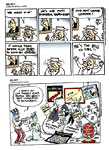
Toon1.jpg)
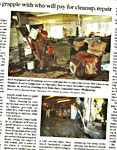


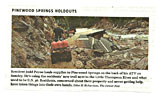
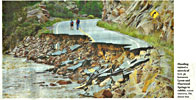
Toon2.jpg)
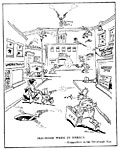
Toon3.jpg)
Toon4.jpg)
Toon5.jpg)
Toon6.jpg)
Toon7.jpg)


1.jpg)
2.jpg)
3.jpg)
4.jpg)
